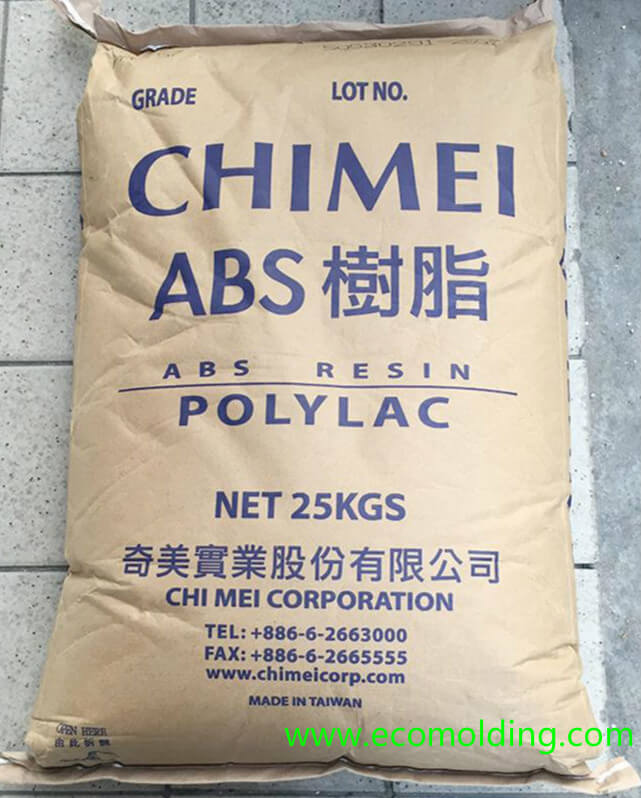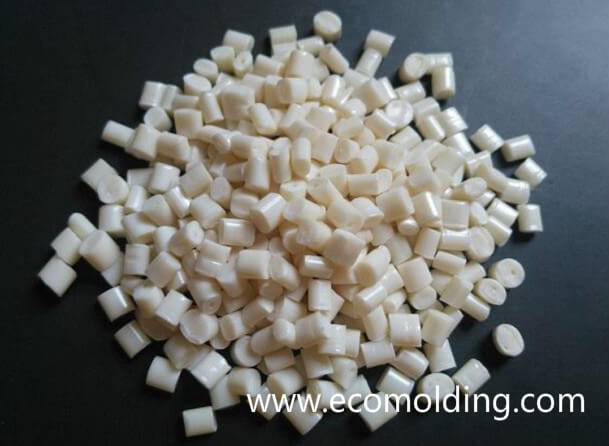What Is the ABS injection molding Material?
Commonly known as ABS injection molding material, Acrylonitrile Butadiene Styrene is an opaque thermoplastic polymer. ABS is amorphous and therefore has no true melting point. Thermoplastic (VS “thermoset”) describes how the ABS plastic responds to heat. A thermoplastic material becomes liquid when heated to a certain temperature level (105 degrees Celsius in the case of ABS material). Significant degradation will not happen after they go through the process of heating to their melting point, cooling and reheating. Thermoplastics like the ABS plastic will not burn. Instead, they will become liquid, so they can be easily injection molded and then recycled. On the contrary, the thermoset plastic materials only allow for one-time heating (especially during the plastic 1injection molding process). When being heated for the first time, the thermoset materials will set (like a 2-part epoxy), leading to a chemical alteration that is impossible to reverse.


Why Is ABS So Commonly Used?
The ABS plastic is strongly resistant to chemical corrosion, as well as physical impacts. It allows very easy machining and features a very low melting point, making it a perfect fit for the plastic injection molding process and 3D printing via a fused deposition modeling (FDM) machine. And, relatively speaking, ABS is inexpensive, of which the cost usually falls between those of Polypropylene (PP) and Polycarbonate (PC). Because of its low melting temperature, the ABS material is usually not applied in high heat conditions. By virtue of these properties, ABS can be widely used in a great number of project applications across an extensive range of trades.
What Are the Purposes of the ABS Plastic?
The ABS material can be used in a wide range of applications, among which the most commonly seen ones are computer keyboard keys, housing of a power-tool, the plastic protective covering of wall sockets (usually a blend of PC and ABS) and LEGO parts.
Is ABS Toxic or Harmless?
ABS is deemed relatively harmless, since it does not contain any known substances that cause cancer, and exposure to it does not result in any known adverse effects on health. However, ABS is usually not a good fit for production of medical implants.
What Properties Does the ABS injection molding Material Possess?
As its name indicates, ABS is composed of 3 monomers: acrylonitrile, butadiene and styrene, each of which passes on different properties: hardness, and resistance to chemical & heat from acrylonitrile; processability, surface gloss and strength from styrene; toughness and resistance to impact from butadiene. With regard to morphology, ABS is amorphous.
Through polymerization, the 3 individual monomers combine into a terpolymer with 2 phases: a continuous phase of styrene-acrylonitrile (SAN) and a dispersed phase of polybutadiene rubber. The ratios of the 2 monomers and the molecular structure of the 2 phases affect the properties of the ABS material, which allows product design great flexibility, and subsequently, hundreds of different grades are made available on the market. Thanks to these available grades, varied characteristics, such as low to high impact resistance, low to high surface gloss and low to high heat distortion are made possible.
In the paragraphs that follow, we would like to dive deeper into the ABS injection molding process. ABS features a fluidity that is between that of PS and PC .This influences the injection molding temperature and injection molding pressure, and vice versa. As a result, to lower melt viscosity and improve the cavity filling performance, a higher injection molding pressure is usually applied.
What Are the Injection Molding Processing Conditions of ABS?
Dry ABS tends to absorb moisture, so it is required to be dried prior to processing. It is suggested that the ABS is dried under 80 – 90 degrees Celsius conditions for at least 2 hours, so as to restrict the moisture content of the material to less than 0.1%.
Melting Point: 200 – 280 degrees Celsius; Aim: 230 degrees Celsius
Plastic Injection Molding Pressure: 50 – 100 MPa
Material Pre-treatment: The moisture absorption rate of the ABS plastic is around 0.2% – 0.8%. For common ABS grades, drying must be performed prior to processing. It needs to be dried under 80 – 85℃ conditions for more than 2 – 4 hours or baked in a drying hopper at 80℃ for 1 – 2 hours. Usually, the regrind material should be kept within 30%, while no recycled material should be used for the Plating Grade ABS material.
Gate & vent design: the diameter of the channel should be set at 3mm and the thickness is kept the same as the part, gate length should be less than 1mm, the width of the vents is set between 4 and 6mm, and the thickness between 0.025 – 0.05mm.
Speed of Injection Molding: For flame resistant grade ABS material, a slow injection molding speed should be applied. If product surface is highly required, a high speed or multi-stage injection molding should be applied.
Back Pressure
To avoid wear, the back pressure should be minimized as much as possible, usually 5 bar.
That said, a high back pressure is able to ensure a uniform mixing.
Secondary Operations: The ABS injection molding material can also be used in secondary operations, e.g. ultrasonic welding and decorated moldings, which follows the hot stamping, pad printing or laser marking processes.
Additional Information
After being melted, some grades of the ABS plastic (in particular, the flame retardant ones) strongly adhere to the screw surface, and it will break down after staying on the screw for a certain period of time. Therefore, you need to regularly clean the screw with PS.
That’s all about the ABS injection molding process and I hope this could be of help to you. We are a injection molding manufacturer offering a diversity of plastic mold products. Please don’t hesitate to contact us for more information.
